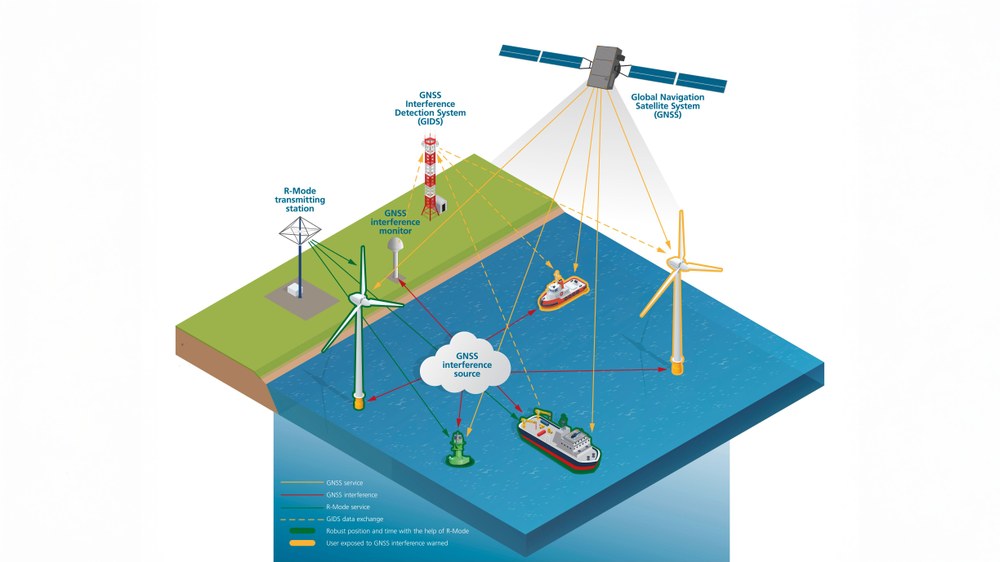Towards standardisation – satellite-independent navigation in the Baltic Sea



- As part of the ORMOBASS project, DLR is leading the development, construction, testing and standardisation of the Ranging-Mode (R-Mode) terrestrial navigation system in the Baltic Sea.
- The existing R-Mode test field between Germany, Poland and Sweden is being extended to Finland and Estonia.
- A new IALA guideline on medium-wave R-Mode signals forms the basis for the functional and geographical expansion of the R-Mode system, which is planned for 2025.
- Focus: Transport, maritime safety, navigation
Efficient maritime transport – both outside Europe and within the Baltic Sea region – is crucial for the German economy. Shipping frequently faces disruptions when global satellite navigation systems, such as Europe's Galileo or the American GPS, are disrupted or fail. Signal disruptions can cause a ship's bridge system to display no position information, or worse, incorrect information, significantly increasing the risk of groundings or collisions. The German Aerospace Center (Deutsches Zentrum für Luft- und Raumfahrt; DLR), in collaboration with research institutions, authorities and industry, has developed an alternative to such satellite-based systems. The Ranging Mode (R-Mode) terrestrial navigation system is now in the standardisation phase and is set to be implemented in an expanded test area, including Finland and Estonia, in 2025.
Between 2017 and 2021, DLR and project collaborators developed and established the world's first large-scale testbed for the radio-based R-Mode system. "This first step towards establishing a maritime backup system in the Baltic Sea region has demonstrated that R-Mode technology works in practice as an alternative terrestrial navigation system, enabling ship positioning even without satellite-based systems," says Anke Kaysser-Pyzalla, Chair of the DLR Executive Board. "With this, DLR is not only making an important contribution to maritime safety, but ultimately also supporting economic performance."
R-Mode – a cost-effective backup to satellite navigation systems
The DLR Institute of Communications and Navigation is working on technologies to detect and suppress interference with global satellite navigation systems, ensuring the availability and reliability of navigation data using alternative sensors and systems. Initiated by the Federal Waterways and Shipping Administration (WSV), DLR researchers developed the alternative Ranging Mode (R-Mode) terrestrial radio navigation system. R-Mode uses existing infrastructure from national maritime organisations to provide radio services in the medium-wave and very high-frequency ranges, offering a cost-effective supplementary navigation service. Over the past seven years, a test area comprising eight R-Mode transmitters has been established over approximately 800 kilometres between Heligoland and Stockholm.
In addition to DLR, other research institutions, maritime authorities and industrial companies are using the test area to help establish and validate the R-Mode technology and develop prototypes of R-Mode-based receivers and applications.
Expansion of the R-Mode test field in the Baltic Sea region
The ORMOBASS project, launched in 2023, is currently expanding the test area to cover the Baltic Sea region between Sweden, Finland and Estonia – a region that frequently reports navigation system disruptions. In 2024, researchers analysed the existing medium-wave signal stations (radio beacons) in the region and, together with the existing transmitters in the test area, developed a concept for expansion. This plan, which encompasses the system's basic functions, will be implemented in 2025 and 2026. The goal is to develop all essential functions of the R-Mode system for both frequency bands – medium and very high frequency – by 2026, making them available to the relevant maritime authorities for operation. In addition to project management, DLR is responsible for the development of R-Mode receiver technology, system design, testing and standardisation.
Standardisation – the path to system approval
For ships to use the R-Mode system during their passage between two ports, transmitters must offer a uniform R-Mode service, and on-board receivers must be approved for maritime navigation. Both of these requirements depend on the standardisation of R-Mode by various organisations. For the medium-wave part of the R-Mode system, the concept developed in the ORMOBASS project – along with results from previous projects in the Baltic Sea region and from DLR's Transport and Security programmes – were successfully incorporated into the new IALA (International Organisation for Marine Aids to Navigation) guideline on medium-wave R-Mode signal characteristics and navigation messaging. Experiences from Canada and South Korea were also taken into account. The result of this five-year effort, IALA Guideline 1187, has been available to all interested parties who wish to use medium-wave R-Mode signals since early 2025.
In the ORMOBASS project, researchers have now begun implementing this guideline in the Baltic Sea region. From early 2026, the standardised signals will be available in the area between Germany, Finland and Estonia.
Related links
About ORMOBASS
The Operational R-Mode Baltic Sea System (ORMOBASS) to support resilient navigation marks a significant step towards ensuring reliable navigation in the Baltic Sea. By introducing the terrestrial R-Mode system as an alternative to global satellite navigation systems, the resilience of maritime traffic will be considerably strengthened. This innovative solution will not only reduce navigation errors but also improve the safety of shipping in one of the world's busiest maritime lanes. The project is being conducted in close collaboration with national authorities, research institutions and maritime industry collaborators, all working together to develop and implement R-Mode technology. This collaboration plays a key role in the sustainable and secure development of the maritime sector and offers a pioneering approach to addressing the challenges of modern shipping.
Project participants
- German Aerospace Center (DLR)
- Federal Waterways and Shipping Administration, Germany (WSV)
- Swedish Maritime Administration, Sweden
- Federal Maritime and Hydrographic Agency, Germany (BSH)
- Finnish Transport Infrastructure Agency, Finland
- Fintraffic VTS Ltd, Finland
- RISE – Research Institutes of Sweden
- NavSim Poland Ltd., Poland
- Alberding GmbH, Germany
- Estonian State Fleet, Estonia
- Kongsberg Discovery AS (Seatex), Norway
